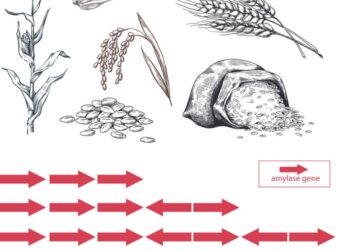Cutting farm nitrous oxide emissions helps climate and ozone layer
Cutting farm nitrous oxide emissions helps climate and ozone layer
-
Adding crushed basalt rocks and special fertilisers can reduce potent nitrous oxide (N2O) greenhouse gas emissions and safeguard the stratospheric ozone layer, which protects us from harmful UV light and reduces nitrate leaching into water bodies protecting ecosystems and human health
-
The new study, led by researchers at the University of Sheffield, highlights methods for reducing N2O emissions, such as enhanced weathering of agricultural soils with crushed basalt, that offer a cost-free co-benefit for N2O mitigation with financial savings for farmers whilst helping them achieve climate goals
-
The findings emphasise the importance of N2O mitigation for sustainable agriculture, aligning with efforts to reach net-zero emissions and supporting increased food production for a growing population
Farming methods can reduce nitrous oxide emissions without slowing down the overall recovery of the ozone layer, results from new research have shown.
Nitrous oxide (N2O), a powerful greenhouse gas which is 300 times more potent than CO2, is building up in the atmosphere at an alarming rate. Agriculture contributes significantly to N2O emissions.
New research, conducted by the University of Sheffield, showed that using special fertilisers and crushed basalt rocks (enhanced rock weathering) has the potential to reduce agricultural emissions of N2O without harming the ozone (O3) layer.
There is an international focus on developing N2O reduction strategies to stop soil from releasing nitrous oxide into the air but there have been concerns that cutting these emissions might slow down the recovery of the ozone layer.
The research team, from the University of Sheffield’s Leverhulme Centre for Climate Change Mitigation, used a state-of-the-art earth system model to simulate the effects of reducing N2O emissions, using fertilisers with nitrification inhibitors and enhanced rock weathering, across two different climate scenarios, both following international agreements to protect the ozone layer.
The model allowed the research to take into account how other important gases (like CFCs) and future climate conditions affect the atmosphere. The scenarios differed in how much the Earth’s temperature would rise. Reductions of N2O considered in the analysis represented a feasible planned strategy and demonstrated how this reduction strategy might impact the ozone layer under a variety of future conditions.
The study, published in the Nature Journal npj Climate and Atmospheric Science, is unique in that it bridges climate change mitigation and ozone layer protection, highlighting the dual benefits of N2O reduction strategies which can provide substantial climate benefits by cooling the planet from reducing N2O, protecting the O3 layer and hence not impacting harmful UV rays, and environmental benefits by reducing nitrate leaching into water bodies and natural habitats. This integration is important for developing comprehensive environmental policies.
The research was led by Dr Maria Val Martin and Dr David Beerling from the School of Biosciences and the Leverhulme Centre for Climate Change Mitigation at the University of Sheffield and conducted by Dr James Weber, former postdoctoral researcher at the University of Sheffield.
Dr Val Martin, UKRI Future Leaders Fellow at the University of Sheffield’s School of Biosciences and co-author of the study said: “The results showed that a feasible use of fertilisers with nitrification inhibitors and enhanced rock weathering could cut agricultural N2O emissions by about 25 per cent without hindering ozone recovery.
“This supports the alignment of agricultural practices with international climate and ozone protection policies, such as the Montreal Protocol and we hope this will influence policymakers to integrate N2O mitigation measures more robustly into climate action plans and potentially lead to new regulations and incentives for farmers to adopt these practices.”
The economic analysis from the study also showed cost-free co-benefits of enhanced weathering practices for N2O reduction.
Professor David J Beerling, Director of the Leverhulme Centre for Climate Change Mitigation and co-author of the study said: “The findings emphasise the importance of N2O mitigation for sustainable agriculture, aligning with efforts to reach net-zero emissions while still supporting increased food production for a growing population.
“The study has highlighted cost-effective methods for reducing N2O emissions, such as enhanced weathering of agricultural soils with crushed basalt. These practices offer financial savings for farmers and can reduce the overall cost of achieving climate goals, benefiting taxpayers and consumers.”
Overall, this research shows that reducing N2O emissions from farms is a safe and effective way to fight climate change while protecting the ozone layer. It is hoped that this will lead to new farming practices that are good for the planet and for people.
To read the full study, please visit:
ENDS
Notes to Editors:
For more information about research at the University of Sheffield’s School of Biosciences, please visit: https://www.sheffield.ac.uk/biosciences
Biosciences at Sheffield is rated 4th in the UK for the quality of research
For more information about the Leverhulme Centre for Climate Change Mitigation visit:
Journal
npj Climate and Atmospheric Science
Article Title
Global agricultural N2O emission reduction strategies deliver climate benefits with minimal impact on stratospheric O3 recovery
Discover more from Science
Subscribe to get the latest posts sent to your email.



